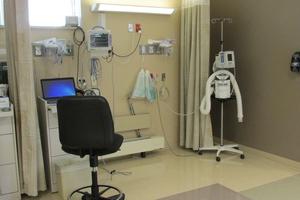Recovery
After your surgery you will be moved to the recovery room also called the post anesthesia care unit (PACU).
You will be closely monitored as the anesthesia wears off. When you are ready, you will return to your room or be discharged home.
How will I feel?
- Medications may be offered to reduce nausea if you experience nausea or vomiting during surgery.
- You might have a mild sore throat after surgery. This may be caused by the airway or tube placed in your mouth during anesthesia.
- If you had an intravenous needle in your arm or hand, it may result in some discomfort. Any soreness or black and blue marks from needles should disappear in a few days.
- Some patients may wake up with a small tube (catheter) in their bladder. This is temporary and easily removed by your health care provider.
- Because of the anesthesia, you won't remember much about your operation.
- You might be unsteady on your feet. The doctor or nurse will tell you when to try to walk.
Your Role in Recovery
 Recovery Room
Your role is to become active as soon as possible and gradually increase your activity, while giving yourself time to heal. Rest when you feel tired. To speed recovery, you may be asked to cough, breathe deeply or undertake mild physical activity. A nurse will explain.
Recovery Room
Your role is to become active as soon as possible and gradually increase your activity, while giving yourself time to heal. Rest when you feel tired. To speed recovery, you may be asked to cough, breathe deeply or undertake mild physical activity. A nurse will explain.
Deep breathing and coughing will keep your lungs clear, aid circulation and help prevent pneumonia. The first time you are asked to cough will be the hardest. Depending on your surgery, try holding a pillow over the incision for support. Tips for breathing and coughing are as follows:
- Slowly breathe in through your nose until you feel your belly balloon out.
- Press your lips together, tighten your stomach muscles, and blow air out.
- On the third deep breath, instead of breathing out the air, cough.
- Repeat this several times each hour.
Ankle Circles
- Lie on your back with legs apart, toes pointed up.
- Slowly turn feet outward, then slowly turn back toward each other. Turn in bed and change position often.
Incision and Dressing Care
After your surgery, you may have an incision covered by a bandage or dressing. There may be a tube in the incision to drain extra fluid. A nurse will demonstrate how to care for your incision and the dressing. Do not change your dressing until instructed to do so by your doctor.
Tips to help your incision heal quickly are as follows:
- To help prevent infection, wash your hands before and after touching the incision area.
- Keep the incision area clean and dry.
- Take warm showers instead of baths (when instructed by doctor).
Caring for Your Incision
Change the dressing as instructed by the nurse or your doctor.
Check your incision for signs of infection, which include:
- Redness
- Swelling or hardness
- Warmth
- Odor
- Pus (drainage)
- Keep your dressing dry
- Fever of 101°F or higher
Call your doctor right away if you have any of these signs of infection.
Location
| Practice Name | Address | City | Phone | Today's Hours | |
|---|---|---|---|---|---|
| OSF Saint Luke - Diagnostic Imaging | 1051 W. South Street | Kewanee | (309) 852-7680 |
7 a.m. - 6:30 p.m.
|
